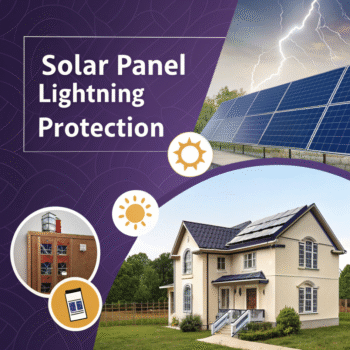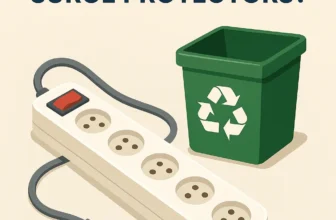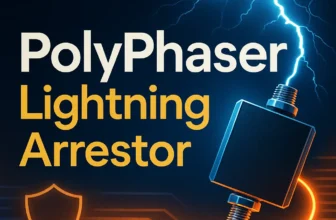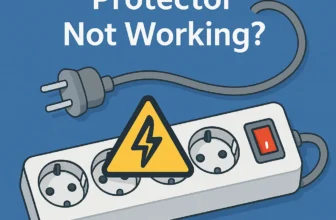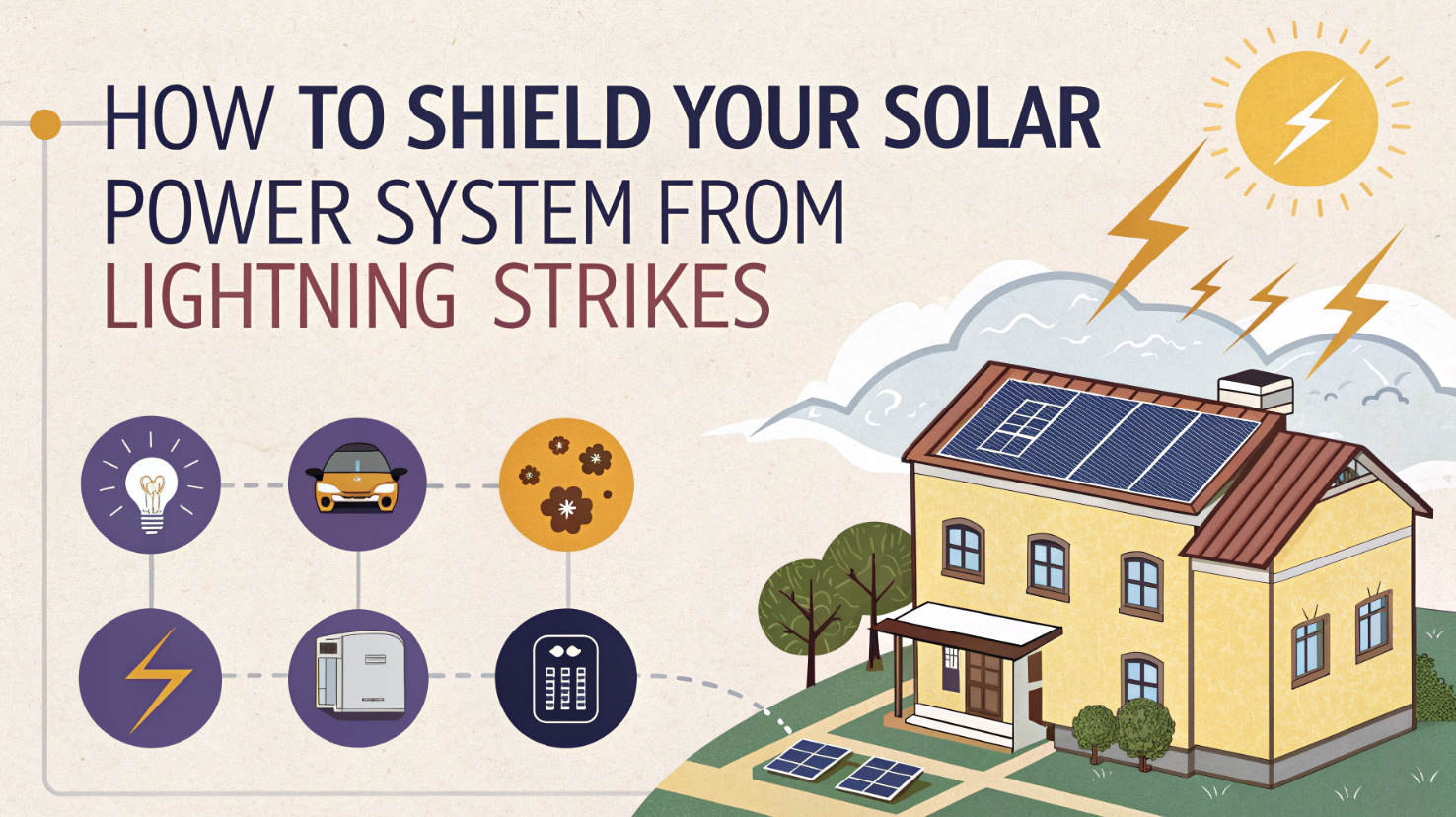
Lightning strikes can wreak havoc on your solar power system. A single strike can cause cracks in solar panels, burnt-out circuits, or even melted connectors. These damages reduce the efficiency of your panels, making it harder for them to convert sunlight into electricity.
Surges from lightning often lead to short circuits or damaged wiring, which can result in costly repairs. Even indirect strikes can induce high voltage surges, harming inverters and controllers. Solar panel lightning protection is essential to prevent these issues and ensure your home system remains safe and efficient.
Why Solar Panel Lightning Protection is Critical
Risks of Lightning Strikes
Direct strikes and their impact on solar panels and inverters
Lightning strikes can directly hit your solar power system, causing severe physical and electrical damage. The intense heat from a strike can crack or even melt solar panels, rendering them unusable. Inverters, which are critical for converting solar energy into usable electricity, are especially vulnerable. High-voltage surges from direct strikes can fry their sensitive electronics, leading to complete failure.
A single lightning strike can carry up to 30,000 amps at millions of volts, overwhelming your system’s protective measures and causing extensive damage to panels, DC wiring, and connectors.
Indirect strikes and induced high voltages
Even if lightning doesn’t strike your system directly, nearby strikes can still cause harm. Indirect strikes generate electromagnetic pulses that induce high voltages in your system’s wiring. These surges can short-circuit electrical connections, damage charge controllers, and disrupt the overall functionality of your solar panel lightning protection setup.
Indirect strikes often go unnoticed until they cause significant issues, making it essential to safeguard your system against both direct and indirect threats.
Financial and Operational Consequences
Repair and replacement costs
Lightning damage to your solar power system can lead to costly repairs or replacements. For instance, replacing a single solar panel can cost between $250 and $600, while inverter replacements range from $1,000 to $2,500. Electrical repairs, such as fixing damaged wiring, can add another $200 to $1,000 to your expenses. If multiple components are affected, total repair costs can escalate to $5,000 or more.
The table below highlights typical costs for repairing or replacing damaged components:
|
Component |
Cost Range |
|---|---|
|
Solar Panel Replacement |
$250 to $600 |
|
Inverter Replacement |
$1,000 to $2,500 |
|
Electrical Repairs |
$200 to $1,000 |
|
Charge Controller |
$150 to $800 |
|
Surge Protection Devices |
$200 to $500 |
Energy production downtime
When lightning strikes, it can damage your system, disrupting energy production. Repairs can take days or even weeks, leaving you without a reliable power source. This downtime not only affects your energy independence but can also lead to higher utility bills if you rely on grid electricity during repairs.
Protecting your system ensures uninterrupted energy production and minimizes financial losses caused by downtime.
Grounding Techniques for Solar Power Systems
Importance of Grounding
How grounding prevents lightning damage
Grounding is one of the most effective ways to protect your solar power system from lightning damage. It connects the metal components of your system to a common grounding point, directing electrical charges safely into the earth. This process provides a direct path for lightning surges, bypassing valuable equipment and preventing damage.
Grounding also discharges static electricity, reducing the likelihood of attracting lightning strikes.
Benefits of proper grounding for system safety
Proper grounding enhances the safety and reliability of your solar power system. It establishes a low-resistance path for fault currents, shielding your equipment from electrical surges and preventing electric shock. Grounding protects sensitive components like inverters and charge controllers, ensuring their longevity.
It also minimizes electrical noise, improving the overall efficiency of your system.
Types of Grounding Systems
Equipment grounding for solar panels
Equipment grounding focuses on safety by connecting all exposed metallic parts of your solar panels to the earth. This prevents electric shock risks and ensures that any stray electrical currents are safely discharged.
For example, grounding lugs can bond the frames of your photovoltaic (PV) modules to the grounding system.
System grounding for overall protection
System grounding connects current-carrying conductors, such as wires, to the grounding system. This type of grounding manages electrical transients and stabilizes the system during lightning strikes or electrical faults.
It complements equipment grounding by providing operational safety and protecting the entire solar power system.
Step-by-Step Grounding Instructions
Tools and materials required
To ground your solar power system, you will need:
-
Grounding rods (8-foot-long, 5/8-inch copper-plated)
-
Bare copper wire (#6 AWG or larger)
-
Grounding lugs for PV module frames
-
Grounding bushings for metal conduits
-
Copper split bolts for secure connections
Connecting the grounding wire to the system
Start by attaching grounding lugs to each solar panel frame. Connect these lugs using bare copper wire, ensuring a continuous path to the grounding rods. Drive the grounding rods into moist soil for better conductivity. Use copper split bolts to secure all connections.
Finally, link the grounding wire to the main grounding system of your house.
Testing and verifying the grounding system
Regularly inspect all ground connections to ensure they remain secure. Use an earth resistance meter to measure the system’s resistance. The resistance should not exceed 5 ohms. If necessary, add more grounding rods or improve connections to meet this standard.
Test soil conductivity and verify proper bonding between components to maintain an effective grounding system.
Protective Equipment for Lightning Protection
Surge Protectors
Functionality and placement in the system
Surge protectors play a vital role in shielding your solar power system from electrical surges caused by lightning. These devices redirect excessive voltage away from sensitive components, such as inverters and charge controllers, ensuring they remain unharmed. They continuously monitor voltage levels and respond instantly to irregularities, maintaining the efficiency of your system. By preventing damage from voltage spikes, surge protectors enhance the longevity of your solar panels and reduce repair costs.
To maximize their effectiveness, place surge protection devices (SPDs) strategically within your system:
-
Install SPDs on the DC inputs and AC outputs of inverters.
-
Ground both positive and negative DC lines.
-
Protect combiner circuits, control circuits, and monitoring systems.
-
For DC cabling under 10 meters, position one SPD near the inverter or combiner box. For longer cables, add SPDs at both ends.
Lightning Rods
Role in redirecting lightning strikes
Lightning rods provide a low-resistance path for lightning to safely reach the ground. Installed at the highest points of your solar array, they intercept strikes before they can damage your system. The grounding system then disperses the energy into the earth, minimizing risks to your equipment.
Installation tips for optimal protection
Follow these best practices for installing lightning rods:
-
Hire a certified professional to design and install a lightning protection system tailored to your setup.
-
Regularly inspect the rods and grounding connections to ensure they remain intact.
-
Use high-quality components that meet industry standards.
-
Integrate the lightning protection system with your solar array’s electrical setup to avoid interference.
Lightning Arrestors
How they differ from surge protectors
Lightning arrestors and surge protectors serve different purposes. While lightning arrestors protect against external surges like lightning strikes, surge protectors handle internal surges caused by electrical faults. The table below highlights their differences:
|
Feature |
Lightning Arrestors |
Surge Protectors |
|---|---|---|
|
Primary Function |
Protects from external surges (e.g., lightning strikes) |
Protects from internal surges (e.g., electrical faults) |
|
Installation Location |
Outside the home or business |
Inside the main panel board |
|
Surge Handling |
Redirects lightning surges directly to the ground |
Diverts surplus energy to the ground through a wire |
|
Usage |
Used for lightning strikes and linked surges |
Used only for electrical surges |
Where to install them in your solar power system
For optimal protection, install lightning arrestors close to the charge controller on the DC side. On the AC side, place them near the inverter’s input and output. If your system includes a backup generator, consider adding arrestors at the generator end.
Ensure all arrestors connect to a robust grounding system to handle excess voltage effectively.
What You Need
Essential tools and equipment for lightning protection
To protect your solar power system from lightning, you need specific tools and equipment. Each plays a critical role in safeguarding your setup. Here’s a list of essential items:
-
Air Terminals (Lightning Rods): These rods intercept lightning strikes and direct the energy safely away from your system. Install them at the highest points of your solar array.
-
Down Conductors: These cables carry the electrical charge from the air terminals to the grounding system. They ensure the energy flows safely without damaging your equipment.
-
Grounding System: This system disperses the lightning’s energy into the earth. It includes grounding rods, copper wires, and connectors. A well-designed grounding system prevents lightning from damaging your solar panels and inverters.
-
Surge Protection Devices (SPDs): These devices shield sensitive components like inverters and charge controllers from voltage spikes. Place them strategically within your system for maximum protection.
Grounding remains the foundation of lightning protection. It provides a direct path for electrical surges to reach the ground, bypassing your valuable equipment. Without proper grounding, your system becomes more vulnerable to lightning strikes.
Sourcing high-quality protective devices
Choosing high-quality protective devices ensures your solar power system remains safe and efficient. Look for products that meet industry standards, such as UL 96A for lightning protection systems or IEC 61643 for surge protection devices. Certified products undergo rigorous testing to guarantee their reliability.
When shopping for equipment, prioritize reputable brands with proven track records.
For example, companies like ABB, Schneider Electric, and Siemens offer durable and efficient surge protectors and lightning arrestors. Compare product specifications to ensure compatibility with your system.
You can also consult with certified solar installers or electricians. They can recommend the best tools and equipment for your specific setup. Investing in high-quality devices may cost more upfront, but it reduces long-term repair expenses and ensures your system operates smoothly.
Tip: Always verify warranties and customer reviews before purchasing protective devices. Reliable products often come with extended warranties, giving you peace of mind.
Installation Best Practices for Solar Panel Lightning Protection
Proper Placement of Solar Panels
Avoiding high-risk areas
Placing your solar panels in the right location is crucial for effective lightning protection. Avoid installing panels in lightning prone sites or areas near tall structures like trees or towers. These objects increase the likelihood of lightning strikes. If proximity to such structures is unavoidable, consider installing lightning rods to intercept strikes and direct the energy safely to the ground.
Additionally, ensure all components of your solar installation are properly grounded to minimize risks.
Ensuring adequate spacing for safety
Spacing plays a vital role in protecting your solar installation. Maintain adequate distance between panels and other equipment to prevent electrical surges from spreading during a lightning strike. Install panels at an angle that maximizes sunlight exposure while allowing rainwater to run off.
Such a setup not only improves energy efficiency but also reduces the risk of water pooling, which can compromise grounding systems. Shield cables and route them carefully to minimize exposure to lightning.
Professional Installation Services
Benefits of hiring certified professionals
Certified professionals bring expertise to your solar installation, ensuring your system is well-protected against lightning. They design and implement grounding systems that safely dissipate electrical charges into the earth. Their work reduces maintenance costs by preventing damage to critical components like inverters and charge controllers. Professionals also enhance safety by minimizing fire and electrical hazards.
With their help, your system operates continuously, avoiding interruptions caused by lightning damage.
Questions to ask about lightning protection
When hiring professionals, ask about their experience with lightning protection systems. Inquire if they use certified equipment that meets industry standards. Confirm whether they conduct thorough inspections of grounding systems and surge protectors.
Understanding their approach ensures your solar installation receives the best protection possible.
Regular Inspections and Maintenance
Importance of routine checks
Routine inspections are essential for maintaining your solar installation’s lightning protection. Regularly check grounding systems, surge protectors, and lightning rods to ensure they function effectively. Inspections help identify potential issues before they escalate into costly repairs.
After storms, verify that all protective measures remain intact.
Key areas to inspect for potential issues
Focus on critical components during inspections. Check surge protection devices for signs of wear or damage. Inspect cable shielding and routing to ensure they minimize exposure to lightning. Examine panel surfaces for debris and clean them to maintain efficiency.
Verify that mounting and framing systems are secure and corrosion-free. Tighten electrical connections and confirm the integrity of the grounding system. These steps ensure your solar installation remains safe and efficient.
Additional Considerations for Lightning Protection
Insurance for Solar Power Systems
Coverage options for lightning damage
Insurance can provide a safety net for your solar power system against lightning damage. Most homeowner insurance policies include coverage for lightning strikes, but you should verify the extent of this protection. Some policies may only cover specific components, leaving others unprotected. Adding solar panel insurance to your policy typically increases your annual premium by a small amount.
However, insurers may dispute lightning strike claims after the fact, so it’s essential to document your system’s condition and any damage thoroughly.
Tips for selecting the right policy
Choosing the right insurance policy ensures your solar power system remains protected. Follow these tips to make an informed decision:
-
Confirm that your homeowner insurance covers solar panels, inverters, and batteries.
-
Review named-peril policies to ensure they include lightning strikes.
-
Notify your insurance agent about your solar installation to adjust your policy for increased home value.
-
Check if ground-mounted systems require additional coverage.
-
Use liability coverage for risks associated with selling power back to the grid.
-
Verify if the installation company has a Hold Harmless Agreement.
-
Consider loss of use coverage to cover living expenses during repairs.
Common Mistakes to Avoid
Skipping grounding or using improper techniques
Grounding is critical for effective lightning protection. Skipping this step or using improper techniques leaves your system vulnerable to lightning damage. Ensure all metal components connect to a robust grounding system that safely directs electrical surges into the ground.
The National Electrical Code (NEC) provides guidelines, but off-grid systems may require additional measures.
Neglecting regular maintenance and inspections
Neglecting routine checks can compromise your system’s lightning protection. Inspect grounding systems, surge protectors, and lightning rods regularly to ensure they function correctly.
After storms, verify that all components remain intact. Failing to maintain equipment increases the risk of undetected issues, resulting in costly repairs.
Potential Challenges and Solutions
Managing complex installations
Urban areas often present challenges, such as limited roof space and shading from tall buildings or trees. These factors reduce the number of panels you can install and their efficiency. To address these issues, consider ground-mounted systems or microinverters that optimize energy output in shaded conditions.
Ensuring compliance with local regulations
Local regulations may vary, affecting your system’s design and installation. Research these rules before starting your project. Work with certified professionals who understand local codes to ensure compliance. This approach minimizes delays and ensures your system meets safety standards.
Protecting your solar power system from lightning strikes is crucial for its efficiency and longevity. Solar panel lightning protection involves grounding, installing protective equipment, and following best practices during installation. Regular inspections and maintenance ensure your system remains safe and operational. Insurance coverage adds an extra layer of security, helping you recover from unexpected damage.
Take proactive steps today to safeguard your investment. A well-protected system not only prevents costly repairs but also ensures uninterrupted energy production for years to come.
FAQ
What happens if lightning strikes my solar panels?
A direct lightning strike can crack panels, damage inverters, and burn wiring. Indirect strikes may induce voltage surges, harming sensitive components. Proper grounding and protective equipment minimize these risks, ensuring your system stays safe and functional.
How often should I inspect my lightning protection system?
Inspect your system at least twice a year. After storms, check grounding connections, surge protectors, and lightning rods for damage. Regular inspections help identify issues early, preventing costly repairs and ensuring continuous protection.
Can I install lightning protection myself?
You can install basic components like grounding rods and surge protectors if you follow guidelines. However, hiring certified professionals ensures proper installation, compliance with local codes, and maximum safety for your system.
Do surge protectors and lightning arrestors work together?
Yes, they complement each other. Surge protectors handle internal voltage spikes, while lightning arrestors redirect external surges from strikes. Using both provides comprehensive protection for your solar power system.
Is lightning protection expensive?
Costs vary based on system size and complexity. Basic grounding and surge protection may cost a few hundred dollars. Investing in high-quality equipment and professional installation reduces long-term repair expenses and ensures reliable performance.

